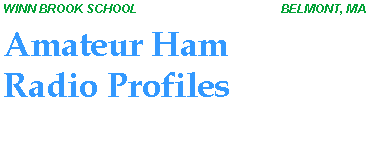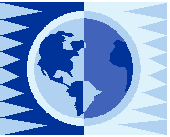

|
Hi,
My name is Larry Wolfgang, and I am an Amateur Radio operator. My Amateur Radio station call sign is WR1B. I grew up in the small town of Gordon, PA, in the hard coal (anthracite) mining region of northeast Pennsylvania. I first became interested in radio when I was about 8 years old, and had joined Cub Scouts. One of the activities in my Cub Scout book was to build a crystal radio set. My dad and I worked together to build a radio from the plans in the book. We used a cardboard tube and wound a coil of wire. We used thin brass strips and the cellophane from the tops of some glass milk bottles to make a capacitor. Then my dad bought a galena crystal and "cat's whisker" to complete our radio. The galena crystal looked like a small rock, something like quartz, and was in a small metal case about ˝ inch in diameter. The "cat's whisker" was just a thin wire on a metal handle. We would move the wire around on the galena crystal until we found the right spot and suddenly we could hear a radio station in my dad's earphones! It was so exciting. Later I built several other crystal radios and had a lot of fun experimenting with circuits and seeing how many different radio stations I could hear. When I joined Boy Scouts, one of the requirements was to learn Morse code and send a message. We had an Assistant Scoutmaster who was a ham radio operator. Of course while he taught us the Morse code, he also taught us about Amateur Radio! It was so exciting to hear him talk about the people he talked to on his radio, and even to visit his "shack" at his house right next to our elementary school. Eventually, two other Scouts -- my friends Garry and Terry -- and I passed our Novice license exams and became hams. My first call sign was WN3JQM. That was in 1968, and I was a high school junior. I'll never forget my first contact with someone other than Garry and Terry. I had called CQ so many times and never heard an answer. One evening a station from New Hampshire answered my call. Hearing him send my call sign in reply to my CQ was such a thrill. My Novice license expired when I went to college. Back then a Novice license was good for only 2 years, and you could not renew it. You had to upgrade to a General class license, and I had not studied enough to do that. In college, one of my physics professors was a ham, and he used to talk about ham radio a lot in class. One day he showed us an experiment he was doing, to receive pictures over the radio. It was called slow-scan TV, and it took 8 seconds to receive a single black-and-white still picture. That looked like so much fun I knew right away I wanted to get my license again. That summer my friend Garry and I studied, practiced Morse code and prepared for our General class license exams. By the end of the summer we drove 100 miles and stayed outside Philadelphia, PA with Garry's aunt. Then we rode a train into the city and went to take our exams. I became WA3VIL in the summer of 1973, and have been a ham ever since. I taught high school science for 6 years, and then took a job with The American Radio Relay League in Newington, CT. My wife and I moved our two young sons from my hometown to Middletown, Connecticut. I became a technical editor, and worked on the monthly magazine QST for several years. Then I became the ARRL License Manuals Editor in 1985, and have held that position ever since. Learning Morse code as a Boy Scout led to my becoming an Amateur Radio operator. My interest in science and technology continued to grow, and eventually led to a career working for the national association of Amateur Radio operators. In many ways I have continued to be a teacher, through the ARRL license study materials and other books I have written and edited. I continue to be very involved with the Boy Scouts of America, too. I became an Eagle Scout in 1970. Two of my three sons are Eagle Scouts. I enjoy introducing Scouts to Amateur Radio, teaching Radio Merit Badge and setting up Amateur Radio stations at Scout Camporees and other activities. I have been part of the K2BSA Amateur Radio staff at the last three National Scout Jamborees, and will be part of that staff at the 2005 National Jamboree at Fort A. P. Hill near Fredericksburg, VA this summer. I helped form the Connecticut Amateur Radio Scouters Amateur Radio Club, with the call sign WA1BSA. The third weekend of October every year is the international Jamboree on the Air (JOTA), a time when Scouts from around the world join up with ham radio operators to talk with other Scouts by ham radio. JOTA is for all Scouts, including Cub Scouts, Boy Scouts and all ages of Girl Scouts. Larry Wolfgang, WR1B
|

|
Photo by Dan Wolfgang |
|
Let’s Meet Mr. Larry Wolfgang |